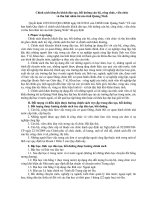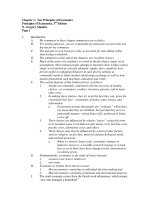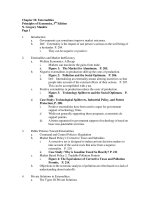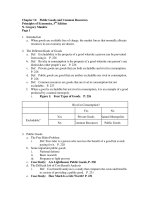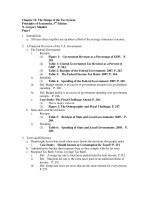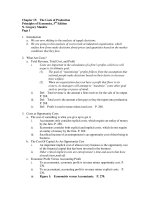Sách khuyến khích đọc - kinhtevimo M12
Bạn đang xem bản rút gọn của tài liệu. Xem và tải ngay bản đầy đủ của tài liệu tại đây (80.03 KB, 2 trang )
Chapter 12: The Design of the Tax System
Principles of Economics, 5th Edition
N. Gregory Mankiw
Page 1
1. Introduction
a. All taxes taken together use up about a third of the average American’s income.
2. A Financial Overview of the U.S. Government
a. The Federal Government
i.
Receipts
(1)
Figure 1: Government Revenue as a Percentage of GDP. P.
242
(2)
Table 1: Central Government Tax Revenue as a Percent of
GDP. P. 243.
(3)
Table 2: Receipts of the Federal Government: 2007. P. 243
(4)
Table 3: The Federal Income Tax Rates: 2007, P. 244.
ii.
Spending
(1)
Table 4: Spending of the Federal Government: 2007, P. 245.
iii.
Def: Budget surplus is an excess of government receipts over government
spending. P. 246.
iv.
Def: Budget deficit is an excess of government spending over government
receipts. P. 246.
v.
Case Study: The Fiscal Challenge Ahead, P. 246.
(1)
This is major concern.
(2)
Figure 2: The Demographic and Fiscal Challenge, P. 247.
b. State and Local Government
i.
Receipts
(1)
Table 5: Receipts of State and Local Governments: 2005. P.
248.
ii.
Spending
(1)
Table 6: Spending of State and Local Governments: 2005. P.
249.
3. Taxes and Efficiency
a. Deadweight losses that result when taxes distort the decisions that people make.
i.
Case Study: Should Income or Consumption Be Taxed? P. 251
b. Administrative burden that taxpayers bear as they comply with the tax laws.
c. Marginal Tax Rates Versus Average Tax Rates
i.
Def: Average tax rate is total taxes paid divided by total income. P 252
ii.
Def: Marginal tax rate is the extra taxes paid on an additional dollar of
income. P. 252
iii.
Def: Lump sum taxes are taxes that are the same amount for every person.
P. 253
Chapter 12: The Design of the Tax System
Principles of Economics, 5th Edition
N. Gregory Mankiw
Page 2
4. Taxes and Equity
a. Def: The benefits principle is the idea that people should pay taxes based on the
benefits they receive from government services. P. 254
i.
Table 7: Three Tax Systems. P. 255
b. Def: The ability to pay principle is the idea that taxes should be levied on a person
according to how well that person can should the burden. P. 254.
c. Def: Vertical equity is the idea that taxpayers with a greater ability to pay taxes
should pay larger amounts. P. 254.
d. Def: Proportional tax is a tax for which high income and low income taxpayers pay
the same fraction of income. P. 255.
e. Def: Regressive tax is a tax for which high income taxpayers pay a smaller fraction
of their income than do low income taxpayers. P. 255.
f. Def: Progressive tax is a tax for which high income taxpayers pay a larger fraction
of their income than do low income taxpayers. P. 255.
g. Case Study: How the Burden of the Taxes is Distributed? P. 255.
mmmmdxxvii. This data ignore transfer payments.
mmmmdxxviii. Table 8: The Burden of Federal Taxes. P. 256.
h. Def: Horizontal equity is the idea that taxpayers with similar abilities to pay taxes
should pay same amount. P. 254.
5. Tax Incidence and Tax Equity
a. Case Study: Who Pays the Corporate Income Tax? P. 257.
i. Most economists believe that workers and customers bear much of the burden
of the corporate income tax.
b. In The News: Questions and Answers about Tax Reform, P. 258.
6. Conclusion: The Tradeoff Between Equity and Efficiency
7. Summary



